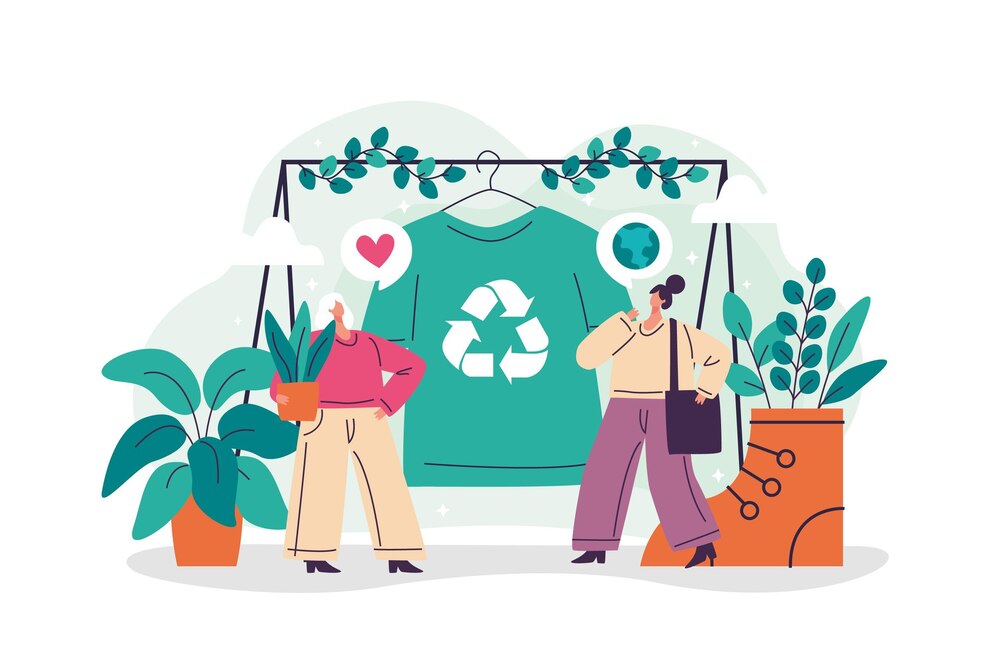SUSTAINABLITY
What is sustainable clothing?
What is sustainable clothing? In today’s world, where the pursuit of zero emissions is crucial, the fashion industry faces criticism for its substantial waste and pollution output each year. With a global population of 7 billion, the demand for clothing significantly impacts the environment. While there have been gradual improvements and innovations, achieving the goal of zero emissions remains distant.
Addressing these challenges requires finding ways to use the planet’s resources responsibly without depleting natural reserves. It also involves developing processes to convert raw materials into fibers without causing air and water pollution. Moreover, handling the billions of used and worn-out garments poses another pressing concern. Let’s delve into the most significant environmental issues caused by the fashion and textiles industry as a starting point.
What you need to know
About the fashion & textiles industry
Textile dyeing is an essential process in the fashion industry, giving fabrics vibrant colors and unique designs. However, this seemingly harmless practice comes with a significant environmental cost. The release of various chemicals during dyeing not only contaminates the air but also seeps into the surrounding land and water sources. As a result, the living conditions near dyeing mills become unhealthy and pose a threat to both human health and the ecosystem. While the fashion world continues to evolve and innovate, the challenge lies in finding ways to mitigate the harmful impact of dyeing on our environment. Responsible practices, such as implementing more efficient dyeing technologies and adopting eco-friendly dyeing methods, can help reduce the environmental footprint of the textile industry.
The overwhelming use of synthetic fibers, such as polyesters and polyamides, presents a significant environmental concern. These fibers are derived from the petroleum industry, known as one of the most polluting industries globally. In addition to their origin, the production of these synthetic fibers demands vast amounts of water for cooling, further straining water resources. Moreover, synthetic fibers contribute to the plastic pollution crisis, as they do not easily biodegrade. Even timeless polyester clothing eventually succumbs to damage and becomes unwearable, leading to the same fate as plastic waste, persisting for centuries in landfills and oceans. As the fashion industry continues to grow, exploring sustainable alternatives and responsible practices becomes imperative to address the impact of synthetic fiber consumption on our planet.
he wastage of resources in the clothing industry remains a pressing concern, with significant consumption of fossil fuels, trees, and water. Particularly, the cotton industry heavily relies on vast amounts of water. While a portion of the clothing produced is sold, a substantial unsold portion ends up in landfills or incinerators, contributing to waste. Out-of-style or worn-out garments also face the same fate, further adding to the waste burden. Considering the global scarcity of water and fossil fuels, the fashion industry has yet to reach a turning point in addressing this issue of wastage. As environmental consciousness grows, finding sustainable solutions and reducing resource consumption become essential goals for the future of fashion.
Cotton farming remains a prominent environmental concern in the textiles industry. Despite accounting for only 2% of global agriculture, the cotton industry consumes a staggering 16% of total fertilizers. This excessive use of fertilizers leads to soil degradation for some farmers in the developing world. Moreover, the pesticides employed by certain cotton farmers are among the most potent pollutants in agricultural practices. Alongside these issues, cotton cultivation demands immense amounts of water, with over 10,000 liters required for just one kilogram of raw cotton. This exacerbates drought and irrigation challenges in the developing world, exemplified by the tragic case of the Aral Sea, which has dried up due to cotton production. Sustainable clothing manufacturers grapple with the responsibility of meeting cotton demand in an environmentally conscious manner, striving to address the impacts of cotton farming on soil and water resources.
The fashion industry’s environmental impact is a global concern, and addressing it requires tackling complex and interconnected issues. However, amid the challenges, there is an opportunity for positive change through sustainable fabric choices.
In this era of constant research and innovation, various countries are leading the way in developing new materials and improving traditional ones to promote sustainability. The collaboration and knowledge-sharing between buyers and suppliers across borders further drive progress in eco-friendly practices. As a responsible manufacturer, we take pride in sharing our sustainability resources with our clients and actively seeking out and sourcing new sustainable materials as per their requirements.

Options in sustainable materials
For sportswear and active wear brands, incorporating natural fibers can pose greater challenges compared to brands primarily selling T-shirts. Additionally, the fashion industry’s ever-changing nature presents another obstacle, as fabric preferences fluctuate with each season.
What your options are
For sustainable clothing production
Recycled polyester (RPET) has gained immense popularity in both sports wear and fashion apparel. Despite its name suggesting it’s made from polyester fabric waste, it is actually derived from other plastic waste, such as bottles. In the 1990s, plastic bottle recycling formed a closed loop, with bottles being recycled into new ones—an efficient process. However, transforming used plastic bottles into sewing threads for RPET involves a complex and energy-intensive procedure.
Limited research has been conducted on the true impact of recycled polyester yarns. In the coming years, more information is expected to emerge, shedding light on its environmental benefits. Some initial studies from China have indicated that the emissions from manufacturing yarns with recycled materials might be higher than those from using virgin materials.
The process of recycling used garments into high-quality sewing threads is equally intricate and requires garments to traverse the globe to reach recycling facilities. Given polyester’s functional advantages over other fabrics, it becomes challenging to avoid its usage. However, improving technology will play a vital role in making polyester a more sustainable option in clothing production. Supporting existing technology is a step towards developing better solutions for the future. At Apptex Clothen, while we acknowledge the potential of RPET, we await further research to fully endorse it as a sustainable solution.
Linen stands out as the most sustainable among all natural fibers. Unlike cotton, its cultivation requires minimal pesticide use. The remarkable aspect of linen lies in its reliance on natural water sources for growth, making irrigation unnecessary. It thrives in regions with abundant rainfall, like Belgium. A noteworthy advantage is that linen can be grown conventionally without the need for organic practices since pesticides are not required in its cultivation. Organic and regular linen are essentially the same.
Embracing linen more extensively in our collections would propel the industry towards significant progress. However, the suitability of linen is highly influenced by fashion trends and seasons, limiting its application to certain garments. Additionally, the price of linen may not be suitable for the lower end of the market. Despite these challenges, for those who can afford it, incorporating more linen into collections would be a positive step forward. Let us begin making strides in the right direction by starting here with linen.
Hemp shares numerous advantages with linen, making it a sustainable choice in the fashion industry. It excels in reducing land and water usage, and its natural properties act as a weed killer. Despite these benefits, hemp cultivation is not widespread in all countries, partly due to its association with marijuana. However, China and France stand out as major producers of hemp. When transformed into fabric, hemp closely resembles the look and feel of linen. By blending it with other fibers like cotton, the hand feel can be enhanced to achieve a softer texture. Incorporating more hemp into your collection will not only benefit your brand but also contribute significantly to the environment.
Organic cotton offers different grades and certifications, with the purest form being GOTS, which ensures organic practices throughout the entire supply chain, from cultivation to the finished product. On the other hand, OCS certification indicates that the raw material is organically grown, but the subsequent processing is done conventionally.
BCI cotton, while not organic in itself, is purchased through an NGO that supports farmers in the developing world to improve their farming methods.
Pima cotton, a long-staple variety grown in the USA, is not considered organic, but it is a product of modern and sustainable cotton farming practices. Both American and Australian cotton adhere to higher standards, using less water and significantly fewer pesticides, making them comparable in sustainability despite not being certified organic.
Although cotton is a natural fiber, it doesn’t automatically guarantee sustainability. A key challenge lies in the substantial amount of water required for cotton cultivation. While it may not be the worst fiber choice, it also may not be the most sustainable option if your brand aims to enhance its environmental footprint. Exploring alternatives and eco-friendly practices can lead to a more sustainable approach.
Cupro and lyocell are man-made fibers derived from wood pulp. While wood pulp-based fibers like viscose are sometimes mistaken for natural fibers, the reality is that their filament-making process can be as polluting as that of polyester. However, cupro and lyocell stand out due to their production through modern technology, significantly reducing their impact on the environment. Notably, Lenzing, an innovative company based in Austria, is at the forefront of developing sustainable fibers like Tencel, their patented brand of lyocell. For brands that can accommodate luxury pricing, Tencel offers an excellent solution for sustainable clothing production. With Lenzing’s commitment to eco-friendly practices, these fibers present a more responsible choice for fashion.
Eco Vero, a novel brand of viscose developed by Lenzing in Austria, stands at the forefront of sustainable fashion. This eco-friendly fiber is sourced from sustainable wood pulp, ensuring a responsible use of resources. Lenzing’s production process adheres to stringent EU environmental standards and proudly carries the ECO label, guaranteeing its eco-conscious credentials.
One of the remarkable aspects of Eco Vero is its traceability. With easy analysis and tracing capabilities, it’s simple to verify whether a product truly utilizes Eco Vero. The versatility of this innovative fiber is another significant advantage. Nearly all popular conventional viscose fabrics, including Crepe Marrocaine, can be seamlessly produced with Eco Vero. The hand feel and appearance are indistinguishable, making it a preferred choice for many brands transitioning to more sustainable practices.
Livaeco is a remarkable fiber crafted by Birla Cellulose in India. Resembling rayon in look and feel, this eco-friendly fiber sets itself apart by being derived from sustainably sourced wood pulp. In contrast to conventional rayon, Livaeco significantly diminishes water consumption, contributes to forest preservation, and lowers C02 emissions. What’s truly remarkable is that garments made from 100% Livaeco can be disposed of at the end of their life cycle and will biodegrade relatively quickly. Livaeco emerges as a promising alternative to rayon or viscose, offering a greener solution for sustainable clothing production.
CIRCULOSE® is a new material made by recycling cotton from worn-out clothes and production waste. To cut it short, cotton waste is recycled into rayon fibre. This is done by a newly developed chemical recycling process that extracts the cellulose from cotton garment waste. This technology has been developed in Sweden by a company called Renewall. Contrary to recycling waste directly into yarns, recycling into fibres allows for much better-quality spinning, and no dependency on blending with other fibres. What’s more, recycling into yarns can only be repeated 2 or 3 times, after which the fibres become to short for further re-processing. Circulose is expected to become a very important sustainable fibre for the future.
